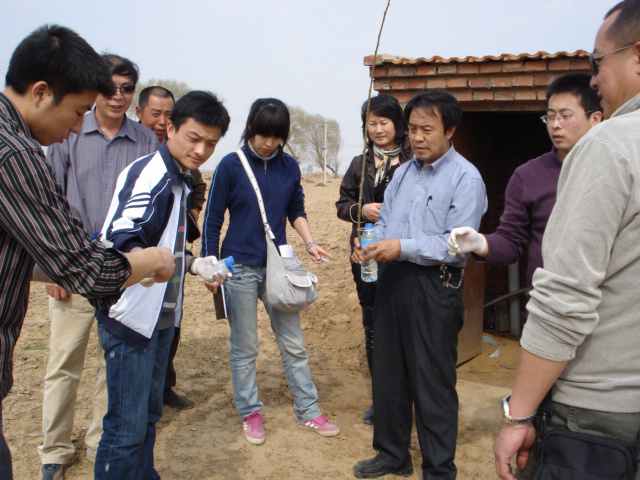
by Darren Cheah Monday, September 9, 2013

Guifan Sun and his students collect water samples in China. Courtesy of Prof. Sun, China Medical University, Shenyang
In China, arsenic poisoning from groundwater has been a known chronic health issue since at least the 1970s. From 2001 to 2005, the Chinese Ministry of Health tested 450,000 wells, 13 percent of which exceeded World Health Organization (WHO) arsenic standards. However, numbers could be far worse, as only about 12 percent of Chinese counties were screened. Now, researchers from the Swiss Institute of Aquatic Science and Technology (Eawag) and China Medical University have developed a predictive model for arsenic groundwater contamination that they say could more efficiently determine regions where high-level arsenic contamination is most likely to occur. Their results, published in Science, showed that main arsenic risk is most likely in northern China.
Using traditional methods of measuring arsenic contamination in wells would take at least 20 years to screen the remaining counties in China, said Guifan Sun, a professor and medical doctor at China Medical University and co-author of the study, in a press release. Sun and his colleagues created their model using environmental proxies such as topography and age and salinity of sediments, based on suitable arsenic-producing geochemical conditions found in reducing or alkaline environments. They then used existing population data to create a map of potential high-risk areas.
Arsenic is naturally present in the rocks of many regions and is especially prevalent throughout Southeast Asia, including Bangladesh, China, India and Vietnam. In the subsurface, geochemical conditions determine arsenic solubility, says Calvin Alexander, a hydrogeologist at the University of Minnesota – Twin Cities who was not involved in the research. Detection becomes increasingly difficult when arsenic is further mobilized by groundwater flow.
The challenge is that there are complex hydrologic conditions that affect groundwater arsenic concentrations in many areas, says Holly Michael, a hydrogeologist at the University of Delaware, who wrote an accompanying commentary in the same issue of Science. Part of that challenge, Alexander says, is that the models take into account only natural factors and neglect human influence. Unfortunately, he says, the effect of humans is most pervasive in well pumping, a process that changes geochemical conditions and increases arsenic mobility in groundwater. Already very heterogeneously distributed — such that wells 10 meters apart can have very different arsenic levels — detection is further exacerbated by well pumping. Many basins affected by arsenic in the subsurface are densely populated, Michael adds, and humans would have changed the hydrogeological systems in these regions to an extent.
Even so, the new predictive model created by Sun and colleagues should help suggest localities with arsenic levels higher than WHO standards, says Charles Harvey, a hydrogeologist at MIT who was not involved with the research. The team’s methods — taking existing maps of land surface characteristics and relating them to existing arsenic concentration data to determine relationships between arsenic-producing conditions and environmental proxies — are not terribly difficult, he says. But the model’s predictions need to be tested for its accuracy, Harvey notes, and then researchers need to determine reasons why some predictions would not be correct in reality.
Predictive models such as this require ground-testing, noted Eawag senior scientist and project initiator Annette Johnson in a press release, and should complement screening efforts, and not serve as a substitute. Predictive modeling may act as a primary method for contaminant detection and mitigation in the future, the team wrote, especially with increasingly advanced techniques for obtaining environmental data.
© 2008-2021. All rights reserved. Any copying, redistribution or retransmission of any of the contents of this service without the expressed written permission of the American Geosciences Institute is expressly prohibited. Click here for all copyright requests.